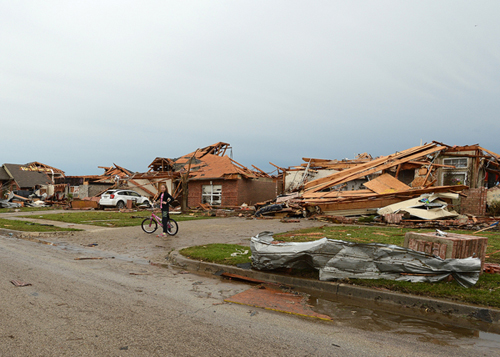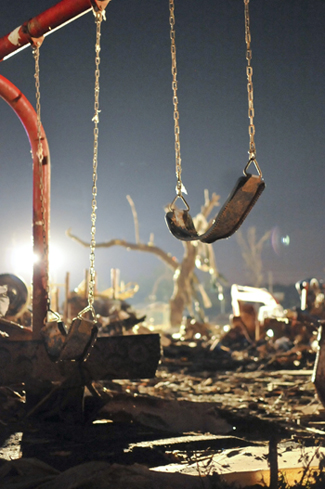 Videos taken within flattened schools by survivors of this week’s Oklahoma tornadoes show the damage through a simple lens. Children see things differently, say experts who add that ways to help them can range from turning off the TV to setting out crayons and paper, to watching for certain behavioral changes.
Videos taken within flattened schools by survivors of this week’s Oklahoma tornadoes show the damage through a simple lens. Children see things differently, say experts who add that ways to help them can range from turning off the TV to setting out crayons and paper, to watching for certain behavioral changes.
“You tend to see the stress they’re under in their behavior rather than really what they say,” said Gale Hobson, speaking on the phone from Moore, Okla. She is a psychologist at the Mercy Clinic in Oklahoma City, which is providing emergency health care around the hardest-hit Oklahoma community.
She ticked off a list of symptoms that community-wide environmental trauma may cause in children: separation anxiety, irritability, fussiness, sleeplessness, falling grades, or fear of storms or going to school.
Her own grandson, Hobson said, had acted out with a tantrum when it was time to separate from his mom and go to daycare. Another grandson, she said, had asked if a tornado was going to destroy his house.
It can take time for symptoms to develop, she added. The signs are not necessarily immediate.
About 8 to 15 percent of individuals exposed to disaster on the scale of the Oklahoma storm will probably develop the kinds of psychiatric disorders like post-traumatic stress disorder or depression that hinder their grades, social interactions and outlook, said Dr. Russell Jones, a professor of psychology at Virginia Tech University, who focuses on children, trauma and natural and technological disasters.
“We’re pretty good at figuring out who will need help,” he said. One of the big predictors is the young person’s proximity to the center of the disaster, what he or she saw, or if they were injured or knew anyone who was injured or killed. The other is a young person’s psychiatric history before a tragedy, if there are prior stresses, like depression.
In mild cases, symptoms of stress, flashbacks, headaches and the like will disappear in days or weeks. Beyond a month of such suffering, Jones suggests seeing a counselor, clergy or other help, with the view of getting a referral to or screening by a psychological professional.
When children are in the room, it’s important to turn off televisions showing nonstop disaster, said both Jones and Hobson. Both counseled that families stick to routines, reassure the children of their safety and pay attention and listen to children, something that can be especially hard when cleaning up a shattered town.

Cynthia Sandusky saw that in Vermont. After Hurricane Irene caused massive flooding and several deaths in August, 2011, some adults were so “naturally consumed” with the basic needs like food and shelter “that a lot of times how the family is feeling, there may not be room or time to address that,” she said.
Sandusky is a former practicing psychotherapist who now directs the Arts Bus Project from Randolph, Vt. The refitted school bus brings artists and art, theater, and music experiences to children in central Vermont’s rural towns. It started running years before Irene, but the storm put the bus in a high gear.
“The arts can be a marvelous vehicle with which children and teens and adults can express those feelings that can be so difficult,” Sandusky said. For children especially, “it can be an easier task to put it in pictures.”
About a month after Irene, the bus came to Bethel, Vt., with paper, crayons, markers and an artist-mentor who invited children to write, draw, sculpt or dramatize what they felt. That and subsequent visits were not psychological therapy, Sandusky emphasized, it was offering children a chance to express their emotions.
Their fears can have more power than they need to have, “like the monster in the closet,” said Sandusky. For some, art is like shining a flashlight in the closet.
Scientists are starting to understand some of the neurobiological impacts that come with trauma.
Jones said studies of child sexual abuse already link that trauma to the survivor’s hippocampus getting smaller. That part of the brain that governs learning. It’s also bad for the amygdala, which normally helps control excitement and hyperactivity.
Trauma also hinders function of the immune system, endocrine system and the cardiovascular system, Jones said.
Nearly two years after Irene, just as this week’s storms hit Oklahoma, an Arts Bus book about the trauma project went through its first print run. “Children, Trauma and the Arts” collects young peoples’ drawings and writings from Vermont, as well as articles from medical and psychological experts.
After the storm, said Sandusky, people always wanted to know what they could do to help. Offer an ear to listen to children, she said. And maybe get out the crayons and glue.
Photo credits: Top image: Official U.S Air Force / Flikr. Bottom image: Staff Sgt. Caroline Hayworth/U.S. Air Force/MCT


























